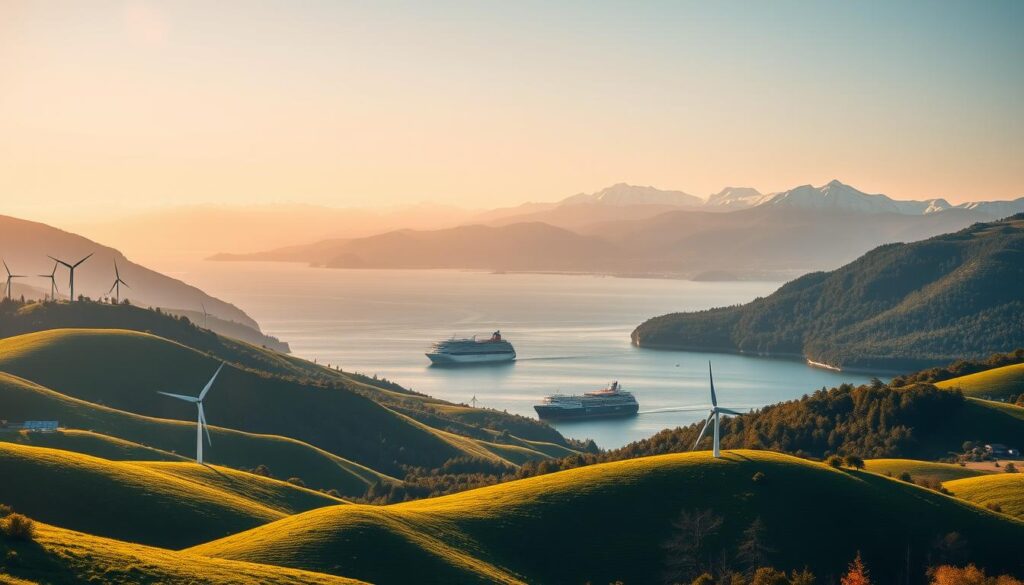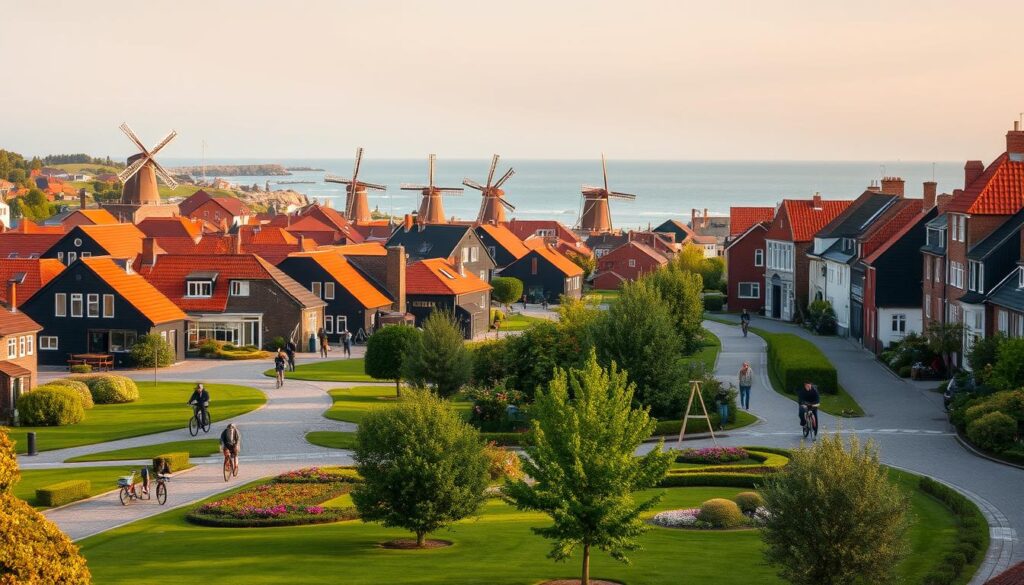
Ever thought about which countries focus most on keeping their environment clean? The answer might amaze you. In a world where pollution is a big issue, some nations really stand out for their efforts to keep things clean.
The Environmental Performance Index (EPI) is a key way to measure how well a country takes care of its environment. It looks at things like air quality, water, and how they handle waste. Countries like Denmark, Finland, and Sweden always score high on the EPI. This shows their strong commitment to protecting the environment.
Keeping a country clean is more than just national pride. It also directly affects the health and happiness of its people. When you look at the cleanest countries, you’ll see the creative ways they work to reduce their impact on the planet.
Key Takeaways
- The EPI is a key tool for checking how clean a country’s environment is.
- Denmark, Finland, and Sweden are among the top countries.
- Keeping the environment clean is good for public health.
- Countries known for being clean focus a lot on managing waste well.
- Good air and water quality are signs of a country’s environmental health.
What Criteria Determine a Country’s Cleanliness?
A country’s cleanliness comes from its environmental policies, public health measures, and waste management practices. These elements work together to show how well a country takes care of its environment. This is measured by the Environmental Performance Index (EPI).
The EPI looks at 40 indicators across 11 areas, like ecosystem health and climate change. A country’s environmental policies are key to its cleanliness. Good policies help cut down pollution, support green practices, and protect nature.
Environmental Policies
Environmental policies are essential for keeping a country clean. They cover things like emissions rules, nature conservation, and green energy support. Countries with strict policies usually have cleaner air and water.
- Rules on industrial emissions
- Efforts to save natural areas
- Support for green energy
For example, countries that focus on solar and wind power are often seen as very clean. This is because green energy cuts down on pollution from fossil fuels.
Public Health Measures
Public health is also key to a country’s cleanliness. It includes access to clean water, good sanitation, and healthcare. Countries with strong health measures have healthier people and cleaner places.
Some important health measures are:
- Clean drinking water access
- Good sanitation systems
- Health education campaigns
Waste Management Practices
How a country handles waste is also important. Good waste management means recycling, proper waste disposal, and less waste overall. Countries with strong waste systems are often seen as very clean.
Good waste management includes:
- Recycling programs
- Safe landfills
- Less waste through education and rules
In summary, a country’s cleanliness comes from its environmental policies, public health, and waste management. By working on these areas, countries can improve their environmental standing and be among the cleanest.
The Role of Geography in Cleanliness
Knowing a nation’s geography is key to judging its cleanliness. A country’s geography can greatly affect its environmental health. This makes some places more likely to be sustainable countries than others.

Natural Resources Impact
Countries with lots of natural resources tend to keep things clean. Having plenty of water, fertile land, and diverse ecosystems helps manage the environment better. For example, places with lots of rain and rivers can keep their water clean.
New Zealand is a great example of how natural beauty helps keep a country clean. Its forests, rivers, and wilderness areas boost biodiversity. They also support eco-tourism, which promotes caring for the environment.
Climate Considerations
Climate is also very important for a country’s cleanliness. Places with mild weather face fewer environmental problems than those with extreme weather. For instance, countries with moderate weather can grow food sustainably, reducing pollution and keeping soil healthy.
But, countries with tough climates, like those with droughts or storms, have their own challenges. Yet, some have found creative ways to overcome these, showing they’re committed to being eco-friendly nations.
Population Density Effects
How crowded a country is also affects its cleanliness. Busy areas produce more waste and pollution, straining waste management. Countries with lots of people, like those in big cities, need good waste systems to stay clean.
But, countries with fewer people might find it easier to keep things clean. They might need to build more to support their communities. Sweden and Finland are examples of countries that manage their population well to stay clean.
In summary, geography is very important for a country’s cleanliness. By using their geography to their advantage, countries can improve their environmental health. This way, they can become known as sustainable countries and eco-friendly nations.
Top Cleanest Countries Ranked
The quest for a cleaner planet has led to some remarkable achievements. Several countries stand out for their environmental stewardship. These nations have made significant strides in maintaining a clean and healthy environment.
Exploring the Global Rankings
Recent Environmental Performance Index (EPI) reports show Estonia, Luxembourg, and Germany at the top. These countries have strong environmental policies and effective waste management. They also have public health measures that contribute to their high rankings.
Estonia leads in digital governance, which helps its environmental management. Luxembourg invests in renewable energy and has strict environmental regulations. Germany is known for its recycling programs and efforts to reduce carbon emissions.
Notable Mentions Beyond the Top
While the top countries get the most attention, others are also making progress. Sweden, Norway, and New Zealand are known for their innovative approaches to sustainability.
Sweden is a leader in recycling and waste management, with much of its waste turned into energy. Norway has protected its natural landscapes and reduced pollution. New Zealand is famous for its pristine ecosystems and efforts to preserve native species.
These countries show that different methods can lead to big improvements in environmental cleanliness. They inspire other nations to follow their examples.
Finland: A Model of Cleanliness
Finland is a top performer in environmental care. It shows how to keep nature clean and beautiful. Learning from Finland’s methods can help us stay pollution-free.

Environmental Initiatives
Finland has many plans to protect its environment. It invests a lot in clean energy, trying to use less fossil fuels. This move to clean energy cuts down pollution and inspires others.
Recycling and Waste Management
Finland’s waste handling is top-notch, with a big focus on recycling. It has recycled over 50% of its waste, cutting down landfill use. By reducing, reusing, and recycling, we can make a difference too.
Finland’s waste system is green. It has advanced recycling and waste-to-energy plants. These plants make heat and electricity from waste.
Public Awareness Campaigns
Finland works hard to teach people about caring for the environment. The government and groups run campaigns to show why it’s important. These efforts have helped make Finns more eco-conscious.
Finland’s community is all about being green. It encourages everyone to help protect the environment. We can do the same by joining local green projects.
Switzerland: A Leading Example
Switzerland is known for its clean environment. It has great waste management, clean water, and strict air quality rules.
Efficient Waste Disposal Systems
Switzerland’s waste systems are top-notch. It focuses a lot on recycling. The country has a detailed recycling plan that starts with separating waste at the source.
This system leads to high recycling rates and less waste in landfills. It saves natural resources and cuts down pollution.
Water Quality Standards
Switzerland’s water is very clean. This is thanks to strict rules and good waste management. You can swim in its lakes and rivers, which are also good for drinking and wildlife.
The water quality is checked often. This makes sure it meets high standards. It shows Switzerland’s dedication to the environment.
Air Quality Regulations
Switzerland has very strict air quality rules. It has rules for car and plant emissions. This makes the air very clean.
Being one of the best air quality countries, Switzerland is a role model. It promotes clean energy and uses less fossil fuels.
Denmark: A Sustainable Country
Denmark is leading the way in sustainable practices, inspiring others to follow. It’s working hard to reduce its environmental impact in many areas, like energy and transportation.
Cleaner Energy Solutions
Denmark is a big player in the renewable energy field. A lot of its electricity comes from wind power. Its wind turbines are among the best, helping Denmark aim to be carbon neutral by 2050.
Investing in cleaner energy solutions helps Denmark use less fossil fuels. It also shows other countries how to do the same.

Urban Green Spaces
Denmark’s cities are built with sustainability in mind. They have lots of green spaces that help nature and give people places to play. Copenhagen’s harbor baths are a great example, turning old industrial areas into lively public spots.
These green efforts make Denmark’s environment healthier. They also improve the lives of its people.
Eco-friendly Transportation
Denmark is also focusing on green transportation. It encourages people to use bikes and electric cars. Copenhagen’s bike-friendly roads make cycling a popular choice, cutting down on pollution.
Denmark is also adding more places to charge electric cars. This helps lower the country’s carbon emissions even more.
Denmark shows us how to live sustainably. By using clean energy, creating green spaces, and promoting eco-friendly transport, it proves a green future is possible. This is thanks to hard work and smart policies.
Sweden’s Commitment to Cleanliness
Sweden is known for its clean environment. It has great recycling programs and uses sustainable energy. As a eco-friendly nation, Sweden works hard to reduce its impact on the environment.
Recycling Programs
Sweden really cares about recycling. A lot of its waste is turned into something useful. Its recycling system is a great example for others.
- Over 50% of Sweden’s waste is recycled.
- Many households participate in curbside recycling programs.
- Sweden’s recycling initiatives have significantly reduced landfill waste.
Investments in Clean Energy
Sweden is big on clean energy. It focuses on wind and hydroelectric power. This move has cut down Sweden’s carbon emissions and made it a leader in clean energy.
- Sweden aims to be carbon neutral by 2045.
- The country has invested heavily in wind power.
- Hydroelectric power is a significant contributor to Sweden’s energy mix.
Nature Conservation Efforts
Sweden also protects its nature. It has many national parks and protected areas. This keeps its natural beauty and wildlife safe for the future.
Sweden’s efforts in recycling, clean energy, and nature conservation show its dedication. It’s one of the cleanest and most sustainable countries in the world.
Norway: Nature and Cleanliness
Norway’s stunning natural beauty is a national treasure. It’s also a result of the country’s hard work to keep the environment clean. Norway is known for being one of the environmentally friendly countries in the world.
Norway balances nature protection with keeping the environment clean in many ways. The country’s beautiful fjords, vast forests, and untouched wilderness are all protected. This is done through laws and by working with local communities.
Protection of Natural Landscapes
Norway has taken steps to safeguard its natural beauty. It has set up national parks and protected areas that cover a lot of the country. These places are vital for keeping biodiversity and ecological balance.

Norway also focuses on sustainable land use. This means planning and managing land use carefully. It ensures that human activities don’t damage the environment.
| Protected Areas | Percentage of Total Area | Main Features |
|---|---|---|
| National Parks | 17% | Fjords, Mountains, Forests |
| Protected Landscapes | 8% | Valleys, Coastlines, Islands |
| Nature Reserves | 5% | Wetlands, Forests, Wildlife Habitats |
Pollution Control Measures
Norway has been proactive in controlling pollution. It has strict rules to limit emissions and waste. This makes the air and water cleaner.
One key strategy is using cleaner energy like hydropower. Hydropower is a big part of Norway’s electricity. This move has helped reduce the country’s carbon footprint.
- Hydropower accounts for over 95% of Norway’s electricity generation.
- Emissions from industrial sources have been significantly reduced through the implementation of cleaner technologies.
- Waste management practices include extensive recycling programs and waste-to-energy facilities.
Norway leads by example in protecting nature and controlling pollution. Its dedication to environmental cleanliness is a model for other countries.
New Zealand: Clean and Green
New Zealand is known for its natural beauty and clean environment. It’s a standout among the cleanest countries globally. The country’s commitment to environmental conservation and sustainable practices sets it apart.
Native Species and Clean Ecosystems
New Zealand is home to many unique native species. These species have evolved over millions of years due to the country’s isolation. Protecting these species and their habitats is a top priority.
Conservation efforts focus on keeping ecosystems healthy. For instance, New Zealand’s forests are vital for climate regulation and biodiversity. These efforts are evident in the country’s thriving ecosystems.
Sustainable Agriculture Practices
New Zealand leads in sustainable agriculture. It uses farming methods that reduce environmental impact while keeping productivity high. This includes organic farming methods and less chemical use. Such practices help preserve the environment and produce quality food.
| Sustainable Practice | Benefit |
|---|---|
| Organic Farming | Reduces chemical use and promotes soil health |
| Efficient Water Use | Conserves water resources and reduces waste |
| Biodiversity Conservation | Protects native species and ecosystems |
New Zealand’s sustainable approach is a lesson for others. By adopting these practices, we can help make the world cleaner and greener. Its dedication to environmental conservation and sustainable agriculture makes it one of the greenest countries globally.
The Role of Education in Cleanliness
Looking at the cleanest countries ranking, we see education’s big role. It helps people understand and care for the environment. This leads to a cleaner, healthier world.
Education isn’t just school. It includes many programs that teach us to care for the planet. By adding environmental lessons to school and community programs, we build a cleaner, greener world.
Environmental Education Programs
Environmental education teaches us why we need to save nature and how our actions affect it. These programs might include:
- Workshops on living green
- Field trips to nature spots
- Projects on recycling and cutting down waste
These efforts not only teach us but also get us involved in saving the environment. To learn more about helping out, you can contact groups focused on the environment.
Community Engagement Initiatives
Getting people involved is key to environmental education’s success. Activities like clean-up events, environmental fairs, and green clubs make people feel they can make a difference.
Working with local groups and businesses is also important. It helps spread the word and makes a bigger impact.
| Initiative | Description | Impact |
|---|---|---|
| Environmental Workshops | Educate on sustainable practices | Promotes eco-friendly habits |
| Community Clean-ups | Engage communities in cleaning activities | Fosters community pride and responsibility |
| Green Clubs | Encourage environmental stewardship | Develops future environmental leaders |
By focusing on education and community involvement, countries can climb the cleanest countries ranking. This helps us build a better, greener future.
How Citizens Contribute to Cleanliness
Did you know your daily habits can greatly impact your country’s cleanliness? Citizens play a big role in keeping the environment clean. Their actions together make a big difference.
Daily Habits and Personal Responsibility
Actions like recycling, using public transport, and proper waste disposal are key. By doing these, you help keep the environment clean. For example, recycling cuts down landfill waste, and public transport lowers air pollution.
Personal responsibility is essential for cleanliness. This means being aware of what you consume, cutting down on plastic, and joining community recycling efforts. Every small action adds up and has a big positive effect.
Volunteer Clean-up Drives
Joining volunteer clean-up drives is another way to help. These events clean up public areas and spread the word about keeping our environment clean.
| Country | Clean-up Initiatives | Participation Rate |
|---|---|---|
| Finland | National Park Cleanups | 85% |
| Sweden | Beach Cleanups | 90% |
| Denmark | Urban Park Cleanups | 78% |
By taking part in these activities, citizens not only help keep their country clean. They also build a sense of community and care for the environment.
Global Challenges to Cleanliness
The world faces big challenges in keeping things clean. Fast changes like urban growth and climate shifts threaten the cleanliness we’ve worked hard for.
Urbanization and Pollution
Urban growth has both good and bad sides for cleanliness. It brings jobs and progress but also more pollution. Cities struggle with air, water, and soil pollution from factories, cars, and trash.
Cities are finding new ways to fight pollution. They’re using green infrastructure like parks and green roofs. This helps cool cities down and clean the air.
- Implementing stricter emission controls for industries
- Promoting the use of electric or hybrid vehicles
- Enhancing public transportation to reduce personal vehicle use
Climate Change Impact
Climate change is another big problem for keeping things clean. Warmer temperatures and changing weather can cause floods. These floods spread pollutants and harm our environment.
Countries known for being clean are fighting climate change too. They’re investing in clean energy and cutting down on carbon emissions.
- Investing in renewable energy to reduce dependence on fossil fuels
- Implementing climate-resilient infrastructure to protect against extreme weather events
- Promoting sustainable agricultural practices to reduce environmental impact
By facing these global challenges together, we can work towards a cleaner world for all.
Tips for Staying Clean in Your Environment
You can make a big difference by changing a few things in your daily life. By adopting cleaner habits and joining community activities, you help keep the environment healthy and clean.
Simple Lifestyle Changes
Small changes in your daily routine can greatly improve environmental cleanliness. For example, using less single-use plastics, recycling more, and saving water are good steps. Start with small actions like carrying a reusable water bottle, using cloth bags, and throwing away trash correctly.
Also, think about how you use energy. Turn off lights, electronics, and appliances when you’re not using them. This can greatly reduce your carbon footprint. By doing these simple things, you help keep our environment clean and healthy.
Community Involvement Ideas
Getting involved in your community is a great way to help the environment. Join local clean-up events, environmental groups, or organize sustainability-focused community events. You can also work with local authorities and organizations to bring cleaner practices to your area.
For more ideas on how to help, check out 20 Tips for Safe, Clean, Healthy. It offers useful tips and strategies for a cleaner, healthier environment.
By making simple lifestyle changes and getting involved in your community, you can help make our environment cleaner and healthier for all.
Conclusion: Learning from the Cleanest Countries
The cleanest countries in the world are great examples for living sustainably. They show us how to take care of our environment. By learning from them, we can make our future cleaner and greener.
Sustainable Living Examples
Finland and Switzerland are leaders in waste management and education. You can live more sustainably by reducing waste and recycling. Supporting eco-friendly projects is also important.
Promoting Cleanliness
Living sustainably is important for your community. Small actions like joining clean-up drives and supporting green policies help a lot. Learning from the cleanest countries can motivate you to make a difference.
By adopting sustainable practices and encouraging others, we can make the world a better place. This mirrors the success of countries that prioritize sustainability.
